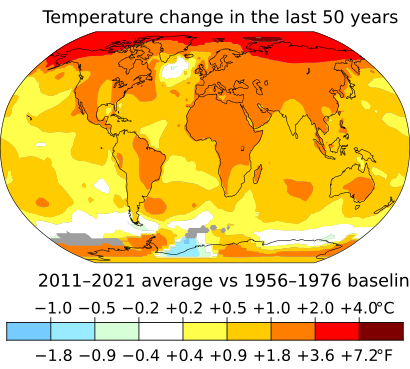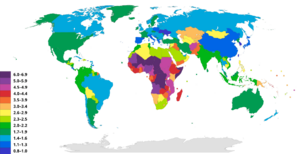Developing country facts for kids
A developing country is a nation that is still working on building up its industries and improving life for its people. These countries often have a lower Human Development Index (HDI) compared to more developed nations. The HDI measures how well people are doing in terms of health, education, and living standards.
There isn't one single way to define a developing country, and different groups like the World Bank and International Monetary Fund (IMF) have their own ways of classifying them. Sometimes, you might hear terms like low and middle-income country (LMIC) or newly emerging economy (NEE) which focus on the economic side.
Developing countries often share some common challenges, often because of their history or where they are located. For example, they might have:
- Less access to clean drinking water, good sanitation (like proper toilets), and hygiene.
- Problems with energy poverty, meaning many people don't have electricity or modern cooking fuels.
- More pollution in the air and water.
- Higher rates of certain diseases, especially tropical and infectious ones.
- More road traffic accidents.
- Generally poorer quality infrastructure (like roads, bridges, and buildings).
Access to healthcare can be limited, and people often have shorter life expectancies. This is due to lower incomes and less public health support. Sadly, problems like infectious diseases, mothers dying during childbirth, and babies dying young are more common.
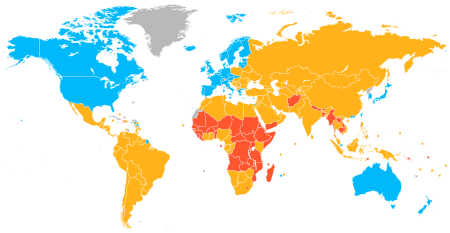
This map shows how the IMF and UN classify countries.
Developing countries also tend to have younger populations. This is because birth rates are often higher, and the population isn't aging as fast as in developed countries.
To help with these challenges, development aid is given by richer countries and organizations. This help supports economic, environmental, social, and political growth. The United Nations has set Sustainable Development Goals (SDGs) for 2030, which aim to solve many of these global problems.
What are common characteristics?
Government and politics
Many developing countries gained their full independence and democracy after the mid-1900s, often after being ruled by European powers. While their political systems vary, most have moved towards some form of democratic government. However, these democracies can face challenges in giving all citizens equal political freedom.
Economy
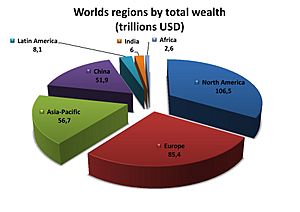
After gaining independence, many developing countries needed a lot of help to build new infrastructure (like roads and power plants) and industries. They often relied on money from foreign countries. However, this sometimes led to a system where richer countries benefited more by getting cheap raw materials and labor. This system is sometimes called neocolonialism, meaning that even without direct control, richer countries can still take advantage of less developed ones.
Organizations like the New International Economic Order (NIEO) were created to try and stop this unfair system. They want developing countries to control their own natural resources and build their own industries. Groups of developing nations, like the BRICS countries, are also working together to have a stronger voice in the world.
What challenges do developing countries face?
Developing countries often discuss global issues like globalization, health, and preventing diseases. This is different from developed nations, which often focus on new science and technology.
Most developing countries share these challenges:
- High levels of poverty: This is often measured by how much money people earn on average. For example, if the average income is very low, a country might be called a least developed country.
- Weak human resources: This means challenges with nutrition, health, education, and adult literacy.
- Economic vulnerability: Their economies can be easily affected by things like bad harvests, changes in export prices, or natural disasters. They also face a higher risk of financial crises.
Urban slums
Many people in developing countries live in slums, which are crowded urban areas with poor housing and services. In 2012, about 863 million people in cities in the developing world lived in slums. In some cities, especially in parts of Africa and Asia, slums are home to a very large part of the population.
Slums grow for many reasons, including:
- Many people moving from rural areas to cities quickly.
- Slow economic growth and high unemployment.
- Poverty and a large informal economy (jobs not officially recognized).
- Poor city planning, natural disasters, and conflicts.
Healthcare and public health
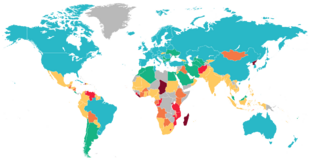
Healthcare is very different in developing countries compared to developed ones. People often have shorter life expectancies due to lower incomes and less public health support. Infectious diseases, mothers dying during childbirth, and babies dying young are much more common. Developing countries also have less access to medical services and struggle to get vaccines, which is important for fighting pandemics like COVID-19 pandemic.
Undernutrition is also more common. Children under five, pregnant women, and the elderly are especially at risk. In 2013, about 165 million children had stunted growth because of malnutrition. Sometimes, both undernutrition and obesity can be found in the same communities.
Other health problems linked to the environment include:
- Illnesses like malaria, tuberculosis, and AIDS.
- Tropical and infectious diseases.
- Unsafe drinking water, poor sanitation, and hygiene.
- Indoor air pollution in developing nations from cooking fires.
- General air pollution and water pollution.
- Motor vehicle collisions and accidental poisoning.
- Non-communicable diseases and weak healthcare systems.
Water, sanitation, hygiene (WASH)
Many developing countries have very limited access to clean water, sanitation, and hygiene (WASH) services. In 2015, the World Health Organization (WHO) said that 2.4 billion people still didn't have proper sanitation facilities, and 663 million lacked safe drinking water. Most of these people live in developing countries.
Energy
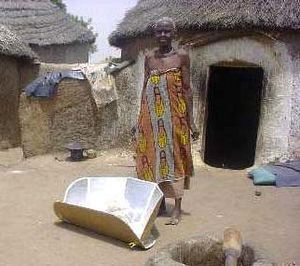
In 2009, about 1.4 billion people worldwide lived without electricity. Many others relied on wood, charcoal, and animal dung for cooking and heating. This lack of modern energy makes it hard to earn money, escape poverty, and causes health problems from indoor air pollution. It also contributes to deforestation and climate change.
Small-scale renewable energy like solar power and improved cookstoves can help. It's often easier and cheaper to produce renewable energy locally in rural areas than to build large power lines. Renewable energy can also help reduce poverty by providing energy for businesses, cooking, heating, and lighting. Kenya is a world leader in using solar power systems.
Pollution
Water pollution

Water pollution is a big problem in many developing countries. It's a leading cause of death and disease worldwide, with over 14,000 people dying daily from water-related illnesses. For example, in India, about 580 people die every day from water pollution-related illnesses. In China, much of the city water was polluted, and many people didn't have access to safe drinking water.
However, some countries are making progress. China has worked hard to clean up its environment since the 2010s, closing polluting factories and enforcing environmental rules. They are also shifting away from coal, which is a major source of pollution.
Indoor air pollution
Indoor air pollution in developing nations is a serious health risk. Many people in developing countries cook indoors using wood, charcoal, or animal dung, often without good ventilation. This smoke causes serious health problems, especially for women and children. In 2012, 4.3 million deaths were linked to indoor air pollution in developing countries. Finding affordable solutions, like better cooking methods and ventilation, is a complex but important goal.
Climate change
Why are developing countries vulnerable to climate change?
Scientists agree that human actions are causing the Earth to warm. This climate change leads to extreme weather, droughts, floods, and rising sea levels, which are dangerous for everyone.
Even though developed countries produce most of the carbon emissions, developing countries are most at risk from climate change. They often have less money, technology, and strong infrastructure to deal with the changes. Countries that are very vulnerable to climate change are called "highly climate vulnerable." This includes many countries in Africa and small island nations.
A 2012 report estimated that climate change causes 400,000 deaths each year, mostly from hunger and diseases in developing countries. There's a concept called "climate justice" that recognizes the unfairness: those who caused climate change the least are suffering the most.
Impacts of climate change
Climate change also hurts economies. In 2010, the poorest countries lost an average of 7% of their economic output due to reduced worker productivity. Rising sea levels cost these countries 1% of their economic output.
Richer countries promised $100 billion annually by 2020 through the Green Climate Fund to help developing countries adapt, but these promises haven't always been met. As the President of France, Emmanuel Macron, said, "Climate change adds further injustice to an already unfair world." Tackling climate change is closely linked to achieving the Sustainable Development Goals, especially Goal 13 on climate action.
Climate change is also likely to increase migration as people move away from areas affected by droughts, floods, and rising sea levels. For example, a 2018 World Bank report estimated that 143 million people in parts of Africa, South Asia, and Latin America might have to move within their own countries.
Despite these challenges, some developing countries are leaders in climate action. Bangladesh, for instance, created a national program in 2009 to adapt to climate change and spends about $1 billion annually on it.
Population growth
Over the past few decades, global population growth has mostly happened in developing countries, which often have higher birth rates. The United Nations believes that family planning can help slow population growth and reduce poverty in these nations.
Population growth, along with climate change and land problems, can also worsen conflicts. For example, conflicts in the Sahel region of Africa have been made worse by these issues.
Poor governance
Many developing countries are considered flawed democracies or authoritarian regimes. After gaining independence, powerful groups sometimes took control of the government.
Building a strong democratic state is often hard due to widespread corruption and nepotism (favoring family or friends). Political instability is also common. To fight corruption, countries are working on:
- Creating fair public administration systems.
- Investigating the causes of corruption.
- Informing citizens about corruption's negative effects.
- Setting rules to prevent abuse of power.
- Creating special laws against corruption.
Other challenges
Other common challenges include:
- Increased pollution from industries and farms.
- Unsustainable use of energy resources.
- High reliance on natural resources, leading to their overuse.
- Child marriage.
- Debt to other countries.
- Poorly performing public services.
- Food insecurity.
- Illiteracy and unemployment.
Many developing nations rely on exporting basic products to richer countries. When richer nations face economic problems, it can quickly affect their developing country trading partners, as seen during the global economic downturn of 2008–2009.
Country lists
Developing countries according to International Monetary Fund
The following are considered developing economies by the International Monetary Fund (as of April 2023):
 Afghanistan
Afghanistan Albania
Albania Algeria
Algeria Angola
Angola Antigua and Barbuda
Antigua and Barbuda Argentina
Argentina Armenia
Armenia Azerbaijan
Azerbaijan Bahamas
Bahamas Bahrain
Bahrain Bangladesh
Bangladesh Barbados
Barbados Belarus
Belarus Belize
Belize Benin
Benin Bhutan
Bhutan Bolivia
Bolivia Bosnia and Herzegovina
Bosnia and Herzegovina Botswana
Botswana Brazil
Brazil Brunei
Brunei Bulgaria
Bulgaria Burkina Faso
Burkina Faso Burundi
Burundi Cambodia
Cambodia Cameroon
Cameroon Cape Verde
Cape Verde Central African Republic
Central African Republic Chad
Chad China
China Chile
Chile Colombia
Colombia Comoros
Comoros Democratic Republic of the Congo
Democratic Republic of the Congo Republic of the Congo
Republic of the Congo Costa Rica
Costa Rica Côte d'Ivoire
Côte d'Ivoire Djibouti
Djibouti Dominica
Dominica Dominican Republic
Dominican Republic Ecuador
Ecuador Egypt
Egypt El Salvador
El Salvador Equatorial Guinea
Equatorial Guinea Eritrea
Eritrea Eswatini (Swaziland)
Eswatini (Swaziland) Ethiopia
Ethiopia Fiji
Fiji Gabon
Gabon The Gambia
The Gambia Georgia
Georgia Ghana
Ghana Grenada
Grenada Guatemala
Guatemala Guinea
Guinea Guinea-Bissau
Guinea-Bissau Guyana
Guyana Haiti
Haiti Honduras
Honduras Hungary
Hungary India
India Indonesia
Indonesia Iran
Iran Iraq
Iraq Jamaica
Jamaica Jordan
Jordan Kazakhstan
Kazakhstan Kenya
Kenya Kiribati
Kiribati Kuwait
Kuwait Kyrgyzstan
Kyrgyzstan Laos
Laos Lebanon
Lebanon Lesotho
Lesotho Liberia
Liberia Libya
Libya Madagascar
Madagascar Malawi
Malawi Malaysia
Malaysia Maldives
Maldives Mali
Mali Marshall Islands
Marshall Islands Mauritania
Mauritania Mauritius
Mauritius Mexico
Mexico Federated States of Micronesia
Federated States of Micronesia Moldova
Moldova Mongolia
Mongolia Montenegro
Montenegro Morocco
Morocco Mozambique
Mozambique Myanmar
Myanmar Namibia
Namibia Nauru
Nauru Nepal
Nepal Nicaragua
Nicaragua Niger
Niger Nigeria
Nigeria North Macedonia
North Macedonia Pakistan
Pakistan Palau
Palau Palestine
Palestine Panama
Panama Papua New Guinea
Papua New Guinea Paraguay
Paraguay Peru
Peru Poland
Poland Philippines
Philippines Romania
Romania Russia
Russia Rwanda
Rwanda Saudi Arabia
Saudi Arabia Saint Kitts and Nevis
Saint Kitts and Nevis Saint Lucia
Saint Lucia Saint Vincent and the Grenadines
Saint Vincent and the Grenadines Samoa
Samoa São Tomé and Príncipe
São Tomé and Príncipe Senegal
Senegal Serbia
Serbia Seychelles
Seychelles Sierra Leone
Sierra Leone Solomon Islands
Solomon Islands Somalia
Somalia South Africa
South Africa South Sudan
South Sudan Sri Lanka
Sri Lanka Sudan
Sudan Suriname
Suriname Syria
Syria Tajikistan
Tajikistan Tanzania
Tanzania Thailand
Thailand Timor-Leste
Timor-Leste Togo
Togo Tonga
Tonga Trinidad and Tobago
Trinidad and Tobago Tunisia
Tunisia Turkey
Turkey Turkmenistan
Turkmenistan Tuvalu
Tuvalu Uganda
Uganda Ukraine
Ukraine United Arab Emirates
United Arab Emirates Uruguay
Uruguay Uzbekistan
Uzbekistan Vanuatu
Vanuatu Venezuela
Venezuela Vietnam
Vietnam Yemen
Yemen Zambia
Zambia Zimbabwe
Zimbabwe
Countries not listed by IMF
Countries that became developed economies
Some countries and regions that were once considered developing have now become advanced economies. This includes places like the Four Asian Tigers (Hong Kong, Israel, Singapore, South Korea, Taiwan) and several European Union countries.
Here are some examples and when they became advanced economies according to the IMF:
 Hong Kong (since 1997)
Hong Kong (since 1997) Israel (since 1997)
Israel (since 1997) Singapore (since 1997)
Singapore (since 1997) South Korea (since 1997)
South Korea (since 1997) Taiwan (since 1997)
Taiwan (since 1997) Cyprus (since 2001)
Cyprus (since 2001) Slovenia (since 2007)
Slovenia (since 2007) Malta (since 2008)
Malta (since 2008) Czech Republic (since 2009)
Czech Republic (since 2009) Slovakia (since 2009)
Slovakia (since 2009) Estonia (since 2011)
Estonia (since 2011) Latvia (since 2014)
Latvia (since 2014) Lithuania (since 2015)
Lithuania (since 2015) Andorra (since 2021)
Andorra (since 2021) Croatia (since 2023)
Croatia (since 2023)
Newly industrialized countries
These ten countries are called "newly industrialized countries" because their economies have grown a lot, but they haven't quite reached the status of a fully developed country yet:
BRICS countries
The BRICS group includes nine major "emerging markets" (countries with fast-growing economies):
 Brazil (since 2006)
Brazil (since 2006) Russia (since 2006)
Russia (since 2006) India (since 2006)
India (since 2006) China (since 2006)
China (since 2006) South Africa (since 2010)
South Africa (since 2010) Egypt (since 2024)
Egypt (since 2024) Ethiopia (since 2024)
Ethiopia (since 2024) Iran (since 2024)
Iran (since 2024) United Arab Emirates (since 2024)
United Arab Emirates (since 2024)
See also
 In Spanish: País en vías de desarrollo para niños
In Spanish: País en vías de desarrollo para niños
- Colonialism
- Economic miracle
- International development
- Land reform
- List of countries by wealth per adult
- Women migrant workers from developing countries




